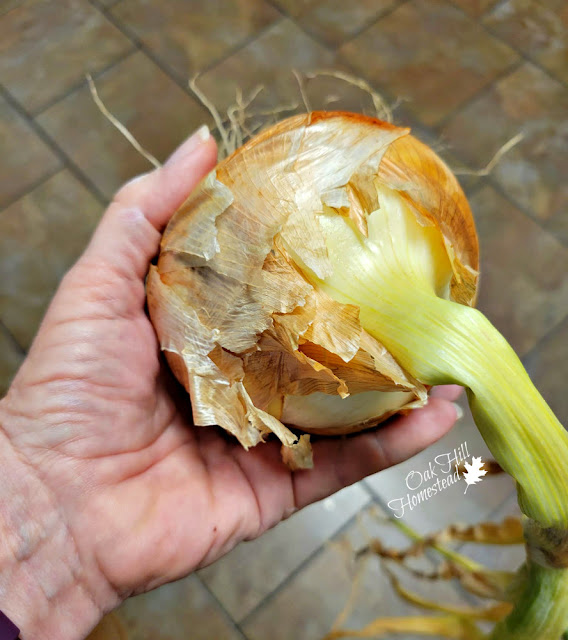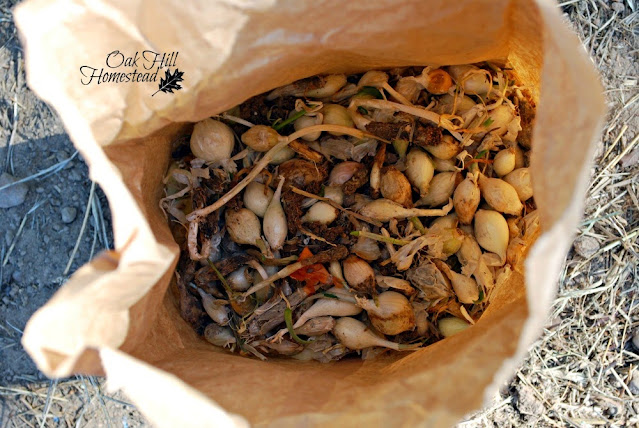Learn how to choose the right type of onions for your region, how to plant onions, and how to grow onions. You'll find my best tips to grow big onions, too.
How to plant and grow onions
I tried for years to grow big onions like those shown in seed catalogs and harvest photos, but my results were always less than stellar.
Those onion sets that I bought every spring - small dried bulbs in net packages that I carefully planted - just weren't giving me the results I wanted.
After doing some deep research and quite a few experiments, I've finally cracked the code, so to speak, and my harvests are full of big, sweet onions now. (Just goes to show that we should always "read the directions" first, right?)
Growing onions isn't hard
Growing onions really isn't that difficult. You just need to know the right type of onion to grow, based on where you live, and the tricks to planting and caring for them.
It's isn't any harder to successfully grow onions than it is to grow them with poor results. Really!
Now, not every onion I harvest is huge and gorgeous, but the majority of them are. Keep reading for my tips and advice.
What is an onion set?
Onion sets (also called bulbs or bulblets) are simply onion plants that were started from seed, harvested early and then dried, to be planted in your garden at home.
Sets can be any onion variety, just like onion seeds and onion plants come in many varieties. Again, you'll need to choose a variety of onion that will grow well where you live.
The difference between onion seeds, sets and plants
There are three ways to buy onions for planting in your own garden: seeds, sets, and plants.
Onion seeds take longer to sprout, grow and reach maturity than onions grown from sets or plants. In fact, it's best to start onion seeds over the winter so they'll have a long-enough season.
Onion sets are what you'll probably find at the store in the spring. A big box store with a garden department, a hardware store that sells seeds and plants in spring, a farm and home store such as Tractor Supply Co, or a local feed store are all good places to look for onion sets.
Sets are small, dry bulbs, usually prepackaged in a net bag. They are often grown to the right size, harvested, dried and allowed to rest over the winter until they are sold in the spring.
Onion sets give you a head start vs growing onions from seeds.
Onion plants (transplants), on the other hand, are grown from seed the same year that they are harvested and sold. Instead of being kept dormant over the winter, they are sold fresh.
Plants are sold in bundles, and each little plant is about two- to four-inches long, with green tops and roots on the bottom end.
If your goal is to produce onions with large, firm bulbs, plants are a better choice than sets.
Are there any advantages to growing onions from seed then? Of course there are. You have a much wider choice of varieties to choose from when you grow from seed. (Be sure you choose a variety with the correct day-length for where you live, as you'll see below.)
For many, many years I bought onion sets to plant in my garden. Then, several years ago, a friend gave me a coffee can full of onion plants. It was a game-changer!
Now I grow onions from plants (transplants, or started plants) instead of from sets.
Which type of onions you should grow
Besides the choice of buying onion seeds, sets or plants, you'll have to decide on what type of onion to grow, and then, finally, what variety.
The type of onion you choose to grow depends on where you live. There are short-day onion varieties, long-day onion varieties and intermediate-day varieties.
To figure out which type of onion would do best in your garden, draw an imaginary line across the United States from west to east. The line begins in the west, near San Francisco, and ends on the east coast somewhere near Washington DC.
It runs roughly along the bottom of New Mexico and Arizona, and across the top of Oklahoma, Tennessee and North Carolina.
If you live above this line, in the northern half of the country, you should grow long-day onions, and if you live in the southern half, you'd grow short-day onions.
Just to make things interesting, there is also a narrow band that runs from west to east right along that imaginary line, and to the north and south of the line, across the middle of the US. If you live inside this band, you can also grow intermediate-day onion varieties.
I consider myself fortunate to live in Oklahoma, where I can grow both short-day and intermediate-day onions!
Because onions will form bulbs according to the number of hours of sunlight, it's important to choose the right type of onions. Growing the wrong type will result in smaller bulbs and a smaller harvest.
What variety of onion should you choose?
Within the onion types, there are many varieties of onions you can choose from. Red, yellow, white, storage onions, sweeter onions... you'll have a choice of varieties.
If you want large onion bulbs, look for a variety that produces large onions. If you're more interested in flavor, read the descriptions and make your choice.
If your goal is to grow onions that keep well, choose a variety that is well-suited to long storage.
How to plant onion seeds
Onion seeds should be started indoors about eight-to-ten weeks before your last frost date. Soak the seeds before planting. Sow seeds about a quarter-inch deep
Transplant the seedlings into the garden in fertile soil with good drainage, just before your average last frost date.
How to plant onion sets
Soaking onion sets before planting - while not necessary - will help them sprout faster.
Plant onion sets one inch deep and five to six inches apart in each direction in fertile, well-draining soil, about 4 to 6 weeks before your average last frost date.
You can plant onion sets slightly closer together if you plan to harvest some early as green onions, so that you are thinning the row as you harvest. The remaining onions will have enough room to form bulbs.
How to plant onion transplants
Plant your onion transplants four to six weeks before the average last frost date. Plant about one inch deep in well-draining fertile soil.
If you plant your onions too deep it will affect their ability to form bulbs.
Space them five or six inches apart. If you plan to harvest some onions early to use as green onions, you can plant them more closely. Harvest every other plant, leaving the rest at least five inches apart. They need this room to form bulbs.
Ideal growing conditions for onions
Raised garden beds are an ideal place to grow onions. Drainage is easy to regulate in raised beds. If you are growing onions in the ground, rake the soil into raised rows about four inches above ground level.
Onions' favorite soil is between 6.0 and 7.0 pH. Adding a generous amount of organic material to the soil will help the plants' small root system by improving the structure of the soil and enabling the soil to hold moisture, but not be soggy.
To get your onions off to a good start, add a bucketful of compost or well-aged (not fresh) manure to the soil and mix it in well before planting.
Onions are heavy feeders. Fertilizer that's high in nitrogen (the first number in the fertilizer's description) is recommended every two or three weeks during the growing season. Blood meal and bone meal are good choices.
They are also thirsty plants, needing an inch of water per week. If your garden doesn't receive this much rain in a week, be sure to water your onions.
Onions need full sun, especially when they begin to form bulbs. Don't plant large, bushy vegetables such as tomatoes where they will shade the onions.
When the bulbs begin to swell in late spring, gently move the soil away from your onion plants with your hands so the bulbs are exposed. Leave only the bottom of the bulbs in the soil. Stop fertilizing.
Grass and weeds compete with onions for both moisture and nutrients, both of which are important for a good onion crop. Keep the onion bed weed-free for best results.
 |
| One of my "Candy" yellow onions, an intermediate-day variety |
Companion plants for onions
Onions are great companion plants for so many vegetables and herbs. They help deter pests from some, attract pests away from others, and improve the flavor of many other crops. Plant onions with one or more of these companion plants for an improved harvest.
- Brassicas such as broccoli, cabbage, cauliflower and more
- Lettuce and other greens, and Asian greens such as pak choi
- Tomatoes, peppers, eggplant
- Strawberries
- Potatoes
- Root crops such as carrots, parsnips, radishes and beets
- Herbs such as chamomile and mint
- Marigolds
However, don't plant onions near these vegetables, as they will stunt the onions' growth:
- Asparagus
- Peas
- Pole beans and bush beans
Can you grow an onion from an onion?
Sometimes you'll have an onion start to sprout on your counter or in your pantry. Can you plant it and grow another onion?
A planted onion will grow an onion plant, but it won't produce another onion bulb.
The plant will produce a flower head in the summer though, and that flower will produce seeds. You can harvest those seeds and plant them to grow more onions.
How to grow big onions
How do you grow big onions? There are several secrets to growing large onions, but your success will also depend on luck. Some years are better than others, no matter what you're growing.
Here are my tips to grow big onions:
- Choose the right type of onions for your location, either short-day, long-day or intermediate-day
- Plant a variety of onion that is known to produce large onions
- Start your onions from plants, not sets, to get a jump on the season
- Plant onions at the right time, and don't plant them too deep
- Don't plant onions next to asparagus, peas or beans, which will stunt onions' growth
- Grow onions in full sun, in soil with lots of organic matter
- Feed/fertilize your onions
- Keep them well-watered, with an inch of water per week
- Gently pull the soil away from the onion bulbs leaving just the bottom portion of the bulb in the soil
Harvesting onions
How will you know when your onions are ripe and ready to harvest? How do you cure onions for storage?
I've actually written another post devoted to this subject, so let's consider it Part Two. You'll find it here: Harvesting and Curing Onions.
I buy my onion plants from Dixondale Onion Farms in Texas.
You can learn how to grow perennial Egyptian walking onions here. They're grown a little differently but taste just as delicious!
Whether you choose to start your onions from seed, sets or transplants, I hope you've been inspired to grow a delicious crop.
For more simple living and gardening posts, subscribe to The Acorn, and join me on Facebook, Instagram and Pinterest.
~~~~~
Facebook | Pinterest | Instagram | Subscribe















